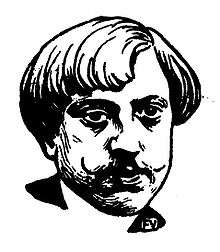Camille Mauclair

Séverin Faust (December 29, 1872, Paris – April 23, 1945), better known by his pseudonym Camille Mauclair, was a French poet, novelist, biographer, travel writer, and art critic.[1]
Mauclair was a great admirer of Stéphane Mallarmé, to whom he dedicated several works, and of Maurice Maeterlinck.[2] He was initially a poet and novelist. His poetry attracted some attention and was set to music by Ernest Bloch, Gustave Charpentier, and Ernest Chausson and Nadia Boulanger.[1][3] His best-known novel is Le Soleil des morts (1898),[1] a roman à clef containing fictionalized portraits of leading avant-garde writers, artists, and musicians of the 1890s, which has been recignized as an important historical document of the fin de siècle.[4] He also wrote several non-fiction books about music including Schumann (1906), The Religion of Music (1909), The History of European Music from 1850-1914 (1914) and The Heroes of the Orchestra (1921) which contributed greatly to French awareness of musical trends in turn-of-the-century Paris.[5]
As art critic at the Mercure de France, he attacked artists such as Paul Gauguin and Henri de Toulouse-Lautrec, though he expressed his admiration when their work became accepted.[6]
Later in life he wrote mainly nonfiction, including travel writing such as Normandy (1939), biographies of writers, artists, and musicians, and art criticism. In his art criticism, he supported impressionism and symbolism,[1] but disdained Fauvism, writing of the style that "a pot of paint has been flung in the face of the public".[7] He also provided the libretto for Antoine Mariotte's 3-act 'conte lyrique' Nele Dooryn, premiered at the Opéra-Comique in 1940.[8]
At the end of his life, he collaborated with the Vichy France-regime, and worked for the Grand Magazine illustré de la Race : Revivre.[9]
He was also a cofounder of the Théâtre de l'Œuvre with Lugné-Poe.[1]
References
- 1 2 3 4 5 Shirlee Emmons & Wilbur Watkin Lewis (2006). "Mauclair, Camille". Researching the Song: A Lexicon. Oxford University Press. p. 303. ISBN 0-19-515202-6.
- ↑ Bertrand Marchal (1998), Mallarmé, Presses Paris Sorbonne ISBN 2-84050-120-1
- ↑ Nadia Boulanger, Ten Songs, Hildegard Publishing Co.
- ↑ Susan Youens (1987). "Le Soleil des morts: A Fin-de-siècle Portrait Gallery". 19th-Century Music. 11 (1): 43–58. doi:10.1525/ncm.1987.11.1.02a00030.
- ↑ Yeoland, R.H. (2009). La Contribution Litteraire de Camille Mauclair Au Domaine Musical Parisien. ISBN 0-7734-4860-8.
- ↑ Jensen, Robert. Marketing Modernism in Fin-de-siècle Europe. Princeton University Press. p. 334.
- ↑ Ian Chilver, ed. (2004). "Fauvism". The Oxford Dictionary of Art. Oxford University Press. Retrieved from enotes.com on February 29, 2008.
- ↑ Wolff S. Un demi-siècle d'Opéra-Comique (1900-1950). André Bonne, Paris, 1953.
- ↑ Romy Golan (1995). "From Fin de Siècle to Vichy: The Cultural Hygienics of Camille (Faust) Mauclair". In Linda Nochlin & Tamar Garb. The Jew in the Text: Modernity and the Construction of Identity. Thames & Hudson. ISBN 0-500-01667-4.
External links
- Works by Camille Mauclair at Project Gutenberg
- Works by or about Camille Mauclair at Internet Archive